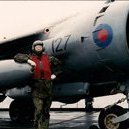Search the Community
Showing results for tags 'Iwata'.
-
Eclipse Side-Feed Takumi Airbrush (ECL350T) Iwata via The Airbrush Company My first slightly reasonable airbrush was the Humbrol airbrush that was pretty far from reasonable if I’m honest, but it was a side-feed airbrush, relying on gravity to help the paint flow out of the cup and into the body from the side, rather than from above, directly in front of the needle. This combines the benefits of gravity working on your behalf to supply your airbrush with paint, with the lack of obstacle right in your view of the front of the airbrush. This certainly renders it worth a look, especially as it’s from Iwata. We’re probably all quite familiar with Iwata, who have an excellent reputation for producing high quality tools for the airbrush artist (we’ll call ourselves artists, why not?), and have been doing so for many years now, with a huge variety of airbrushes of all varieties in their catalogue, in a variety of needle widths, trigger types and cup sizes to suit your line of work. In Japanese art circles, a highly-skilled artist with years of experience under their belt garners the name Takumi, a master craftsman. This airbrush arrives in a cardboard sleeved thick cardboard box, and after cutting the tape the lid slides slowly off to reveal a turquoise foam liner that cradles the airbrush and some additional parts within. The ‘brush is finished in high-gloss reflective chrome, and the 0.24oz/7ml paint cup is removable, sitting above the body within its own cut-out, with another cut-out below for the nozzle spanner, and a final recess for a small tube of Iwata Lube silicone-free airbrush oil. There are other pockets for parts that have been cut but not removed, showing that two larger paint cups could be fitted into the box if a different option was purchased. One looks large enough to take a diluted bottle of your average model paint with ease, and from the drawings on the short instruction sheet, it converts the brush to operate using a syphon feed, further increasing your options. Removing the airbrush is simple thanks to relief around the rear of the cut-out, which shows off the compact body, tipped with a soft clear protector slipped over the crown, the large flat trigger with its grippy surface, and the inlet for the paint cup, which caters for both left- and right-handed users, having two inlets and a stopper than can be transferred between them, allowing paint ingress through either orifice, with the plugged side preventing pass-through. Both fit using friction, thanks to some high-quality milling of the two parts at the factory. Chances are that if you are going to move them, you’ll only do it once unless you are that rare beast – an ambidextrous modeller! The stopper will doubtless get quite a grip of the aperture, so if you ever envisage changing it, make it a regular task to remove it and clean any debris to prevent it silting up and jamming. The handle of the brush has two cut-outs in its sides that allow you to adjust the chucking of the needle without removing the handle, and at the rear is a knurled knob that you can screw in or out to give you a “bump-stop” that will allow you to select the same flow width again-and-again, if for example you are painting mottled camouflage. Removing the handle shows a rubber washer around the join that will help prevent the handle sticking in place on the body. The needle screw is fully visible, and the tension adjuster just in front of it is exposed. If you’re like me, you’ll wind that all the way in at the beginning and only touch it again to either make sure it hasn’t wound back out, or to remove the rear internals by unscrewing them for seriously deep maintenance. At the front, the flexible cap comes off with light finger-pressure, and should be kept handy, as it is useful for back-flushing your brush during cleaning, remembering to put your fingertip over the little hole in the end. The crown is now visible, protecting the delicate ip of the needle from harm during light fumbling or delicate droppage. The four-pronged crown can be unscrewed to offer very slight smoothing of airflow for delicate painting, although the difference is so slight that I might be imagining it, and it might just be that I can both see the surface better, as well as get the needle fractionally closer to my work. The air cap is then visible, and this too unscrews to show the front of the nozzle and the tip of the needle, which is the most delicate part of any airbrush, so should be kept as safe as possible at all times. The very tip of the nozzle has flats on it implying that it can be removed, but the spanner included with this set isn’t suitable for the task, and I understand that the bi-metal nozzles aren’t meant to be separated, so take the hint and leave it in place like a sensible user. Instead, the large spanner grips the flats machined into the outer forward body of the brush, allowing the user to remove that and then free off the teardrop-shaped complete nozzle from its depression, permitting you to remove the needle forward for deep cleaning and to avoid dragging paint through to the rear. The aft section of the nozzle is brass, while the tip where the finest tooling has been carried out is a robust, long-lasting silver-coloured alloy that is unlikely to split unless you handle it very roughly, at which stage you’ll already have bigger problems. Brass wouldn’t hold up very long at all by comparison. In general usage the needle is removed from the rear after loosening the chuck, and here again the compact size of the airbrush shows itself in the length of the needle, which is 0.35mm at its tip, which makes it excellent for a general use airbrush that is capable of a great many spray widths, depending on how you use it. The technical data shows a spray pattern varying from 0.35mm to 50mm, which should suit most modellers’ needs. As proof of this, Iwata have included a small sheet of paper with the instructions that is a test sheet, showing both a tiny, narrow scribble in black that expands to a wide band and then fades out to a hazy trail of paint particles. The 7ml (0.24oz) tapered cup is finished in matching chrome, and has a long horizontal feed tube at the bottom, that mates with the body at the side. The lid has a lip inside to reduce dripping, and the syphon-cut breathing hole in the lid also helps to prevent paint build-up, gravity automatically decanting it back into the cup before it dries. The final part in the box is the lube, which should be used very sparingly away from the paint path to keep the various moving parts from sticking. This tiny tube should last years. The needle packing is PTFE, but unless you’re planning on soaking your airbrush in very ‘hot’ thinners, there shouldn’t be an issue, and I’ve used Mr Self-Levelling Thinners in many many airbrushes with PTFE seals over the years. I've now got a brand-new airbrush lying in pieces on my desk, so I’d better put it back together again and think next about painting something with it. I believe that’s called modelling, I think? In Action It wouldn’t be a review without running a bit of paint through the review sample, so I’ve done that. This is a medium sized needle, so I’ve been using it for medium-sized jobs. I primed a small model with some Alclad Grey Primer, and that came out lovely, with very little in the way of surface preparation needed for the next coat, which was to spray some Mirror by Stuart Semple, which I consider to be the best chrome paint I’ve ever used. It’s not cheap though, but you don’t use much because it’s so thin. The airbrush took both paints in its stride with no problems other than my own clumsiness, which is legendary. When cleaning the primer from the airbrush I managed to loosen the cup and it fell off and rolled down the front of my spray booth. Oopsie! On the upside, it didn’t dribble much paint, and what it did release was easy to clean up, but it illustrates the fact that you should push the cup well into the side of the airbrush, lest it come loose when you’re wiping paint away from the body. The surface of the Mirror came out nice and smooth, with a shiny surface that couldn’t be improved on much without putting real chrome on it. I know this is a review about the airbrush not the paint, but it’s worth noting that the Mirror paint is very thin, and Chrome is a tricky colour to spray consistently. With regard to the offset of the colour cup, I honestly didn't notice it after I’d filled it up with paint. It doesn’t noticeably affect the balance of the airbrush, and visibility is good thanks to the lack of cup in the way, which works for both left- and right-handers just as well if you switch the cup over. The tipped-forward trigger falls nicely to hand and is very grippy, adding little that could block your view of the work in progress, even with your finger in place. Clean-up is easy too, and being able to dismantle the whole nozzle is useful if you leave paint in your airbrush for too long, coupled with the compact nature of the airbrush itself will lend itself to anyone with small to medium hands who might find a standard sized ‘brush feels too large. I’ve got fairly large hands, and didn’t find any issues there, just noticing that it felt quite petite in my hand compared to my usual. Only the truly large-of-hand would find it too small, but then the whole modelling thing might be tricky if your hands are that big. Most gravity fed airbrushes are stuck with the one size of paint cup once you’ve bought them, unless you have the screw-on type. The side feed option takes the benefits of gravity feed with those of the syphon feed, and throws most of the negatives in the bin. The availability of larger cups that can hang downward and turn your ‘brush into a syphon-feed is useful for those that paint larger areas, or like to run several colour cups at once for a quick change. Conclusion This is a good quality airbrush with a feel in use that backs that opening phrase up all the way. It’s a great all-round ‘brush, and comes with everything you need to get going except the hose and possibly a Quick Release (QR) connector if you swap ‘brushes frequently like I do. Highly recommended. Review sample courtesy of
-
I've been looking at Tamiya's airbrushes but I have an Iwata studio series sprint jet compressor. Would any tamiya airbrushes be compatible with this compressor?
- 2 replies
-
- Iwata
- Compressor
-
(and 1 more)
Tagged with:
-
Iwata Eclipse CS Airbrush (HP-CS) Iwata via The Airbrush Company If you don't already airbrush then it might be time to make the leap. I was a brush painter for many years until I took the plunge (don't tell but I still like to brush paint every now and again!). The Air Brush I started with was the Iwata HP-CS and this is still a good AB today for the beginner and the more experienced modeller alike. Iwata make a range of airbrushes from extra wide one through to extreme detail brushes, they cover this in their easy to understand "5 Ways to Spray". They list 5 categories of airbrush. Absolute Precision - Featuring the Iwata Custom Micro. This is specifically designed for extreme details. Total Control - Featuring the Hi Line & High Performance Plus airbrushed. This covers the Fine to Medium spectrum. All Star Versatility - Featuring the Eclipse series of Airbrushes which range from Fine to Wide. Effortless Coverage - Featuring the Revolution and Neo for Iwata Series. Mainly the Medium range for these. Full Finish - Featuring the G-Series and ANEST airbrushes. This is the Wide to Extra wide are. The Eclipse is very much a general airbrush fitting firmly into number 3. It has great coverage on the wider end down to fairly fine lines at the other end and is probably Iwata's most versatile airbrush. It is duel action in that pushing down the trigger releases air, and pulling it back controls the paint flow. It has a 7ml cup which comes with a lid if you choose to use it, the needle size is 0.35mm and it will spray a pattern from this upto 50mm wide. They recommend pressures of 25-35 psi but TBH I find less that this is needed for correctly thinned paint. Also in the box if a small tube of lube for the needle. and a head spanner, though I must admit to only ever tightening the head on mine finger tight. All Iwata airbrushes from The Airbrush Company come with a 10 year guarantee for piece of mind. Conclusion This is a great airbrush for the beginner and the experienced airbrusher alike. It covers most applications the scale modeller will need. If even a slightly ham fisted modeller like myself can get very decent results you know its easy to use! In addition If you need any advise on equipment, then the fine folks at Airbrushes.com (The Airbrush Company) are available and will help you get the best setup for you. Just give them a ring. Very Highly recommended. Review sample courtesy of
-
Universal Airbrush Accessories Iwata from Airbrushes.com Lube Everyone wants to keep their airbrush in top condition, after all they are not cheap. This is a non toxic silicone free lubricant from Iwata which can be used on all moving parts. In particular they recommend applying it to; The Main Lever, Needle Packing, Valve-piston packing, along the needle and the needle cap to enhance paint flow and prevent tip drying. This is a new formula and is now clear. This new formula does not evaporate and maintains its viscosity. Recommended to keep your Airbrush in tip top condition. Spray Out Cleaning Pot This is a universal pot to allow spraying out paint and cleaning products from your Airbrush. This is a glass pot the lower part of which is covered with a removable rubber sleeve. This stops the pot from sliding of your work bench, and if it does in someway will offer some protection from breaking. There is a hanger which will fit all gravity-side-bottom feed and trigger style brushes (sp pretty much all of them then!). There is a filter cap which holds small foam type filters of which you get two spares in the box (these are also available to buy separate). The cap can even hold small parts if you dont want them rolling around. The pot eliminates over-spray when cleaning and its easy to clean up afterwards. The glass bowl when removed from its sleeve is even dishwasher safe. Highly recommended, especially if like me you have just been using an old jar for this. Airbrush Holder / Hanger As the name would suggest this is holder to keep your brush(es) safe on the bench. This is universal and will hold two brushes of any combination. The design holds your brushes securely and prevents them from being accidentally pulled off. There is a heavy duty clamp which will open up to 3 inches (75mm). The box also includes a bracket to attach the cleaning pot to the stand. Workstation As mentioned the Spray out pot can be attached to the airbrush holder to create a Workstation. In addition there are tapped holes and a screw to mount a pressure regulator here as well if needed. If purchased as a work station there is a cost saving as well. Conclusion These are some handy tools from Iwata which will fit most airbrushes out there and will help keep your equipment in good condition. Recommended. Review samples courtesy of
-
Studio Series Compressor Iwata via Airbrushes.com This is a development of the previous Studio compressor, but is smaller, lighter with a relocated outlet and a new style of filter/regulator. The compressor arrives in a fairly small box, with only a poly bag to protect the contents. Included is a two metre plastic hose with a female 3/8" fitting at either end, and a three-pin plug that is already attached to the integral power cord. The compressor is enclosed in a painted metal housing which is open at both ends, with a simple on/off switch on the top, pressure adjustment knob and air outlet, complete with moisture trap on the front, along with a pressure gauge and airbrush holder. The unit also comes with a number of adaptors for use with Badger, Paasche and Aztek airbrushes and a spare airbrush holder. A carry-handle is bolted to the top of the unit. The whole unit measures 25.7cm x 24.1cm x 14m. It weighs in at 5.6kg (12.4lbs in old measures). The compressor operates between 1 and 35psi from the 1.8hp low maintenance oil-free piston motor with the pressure being shown on the clearly marked gauge and controlled by the large knob next to the gauge. Whilst the unit could perhaps been more useful with the addition of a pressure tank, the quietness and full pressure on demand feature means that it’s not such a worry, although you can buy separate tanks should you wish. I’ve been using this compressor for a month or two now and haven’t had any problems with pulsing as can be found on other compressors without tanks and the quietness means that sometimes the only way of knowing whether it’s working or not is by operating the airbrush. It is so much quieter than my old Iwata compressor, which had the air tank built into the handles, that I’ve consigned it to the garage as my spare, as this is now my compressor of choice. Conclusion This is a superb compressor, being easy to use, but with a lot of features that others don’t come with. The moisture trap and pressure gauge being particularly welcome. But it’s the quietness during operation that really is noticeable, being able to hold a conversation on the phone or on Skype whilst using the airbrush is a great improvement over my old model. The only thing I would like to have seen is the replacement of the plastic hose with a nice braided one instead, as the plastic one really didn't like being unwound. Review sample courtesy of
-
Neo Air Compressor Iwata Arriving in a small, quite stylish white box, with a black stripe to one side and the name of the compressor on all faces, this unit is like nothing else. On openng, you are confronted with a small black compressor, power supply, airbrush holder and airline. It looks more like an air pump for a fish tank than a modelling tool. Weighing in at 0.43kg the unit is nice and light, which may make it useful for who model when staying in hotels, and small enough for those with little space, or who don't need a full size compressor and/or tank. The compressor itself is covered in a smooth rubbery material and is simplicity itself to set up. Just attach the power supply, (annoyingly with the plug pins upside down so that it makes it awkward to use anything more than a 4 plug extension block), to the connector on the left hand side, the compressors 1.5m airline to the outlet on the right hand side and the provided airbrush holder into its receptacle, also on the left hand side. The unit has no regulator or water trap, and relies on a push button on the top to turn it on and translate through the three power settings, medium, high and low. Maximum output is 15psi with airflow of 10.5lpm at 0psi using a 12V 24W motor. Maximum duty cycle is 10mins. The compressor does have an automatic bleed valve. In use, the unit is quite quiet, but has an unusual pulsating tone which varies when the airbrush is in use. Whilst there is little control of the pressure, the three settings seem to be enough to be able to get some very reasonable results, (certainly with correctly thinned enamels). Conclusion This is a strange little compressor and I'm really not quite sure which target market it is aimed at, other than the suppositions above. Whilst it does appear to work well and I have had no problems with it over the last few weeks of testing, I'm still not sure about it. Yes, it is quite a bit quieter than my current set-up, but that lack of fine control over the airflow did become a little tiresome. I'm also not sure how the unit will handle high humidity which, having had to empty the water trap on my compressor fairly often is quite a problem, and could mar a good paint job. The other problem with this device is the price, which some would say is a little steep for such a unit. Review sample courtesy of
-
Hello all, Apologies for what is an undeniably 'newbie' question. I've tried searching through this forum but haven't actually managed to find an answer to my question, despite learning a lot of interesting PSI-related things along the way... I've recently become enthralled with modelling aircraft after a long hiaitus, and decided (having been inspired by builds on this and other forums) to invest in an airbrush setup. As is the way with the uninformed, I got a 'terrific' deal via Amazon of a KMS 18 compressor and TWO! dual action airbrushes for a silly amount of money. Too good to be true, of course. The siphon-feed brush is OK I suppose, but the gravity fed brush has caused no end of headaches, culminating in the nozzle shearing, leaving the thread wedged inside the body. It was clean, un-gunged and very carefully replaced - note, this was after cleaning! Game over, not worth replacing. So I've invested in an Iwata Eclipse HP CS, which seems like the ideal brush for the type of work I like to do... My idiotic questions run thus: I understand that there are inaccessible O-rings inside the body of the brush - so will: a) enamel paint/thinners corrode these? (I typically use acrylics, but need to branch out for certain metallic colours) liquid reamer destroy them? c) Alclad or similar lacquers ruin the whole thing? Just looking to prevent expensive mistakes! Any advice (or re-direction to appropriate thread) would be very much appreciated! Al
-
Hello, I need to connect an Iwata Revolution airbrush (HP-TR2) to my Revell Standard Class compressor. Can someone tell me what sort of coupling I need? I'm possibly being slightly dim, but it doesn't seem to be obvious how the advertised sizes relate to the fittings. For example, the hose I have for the airbrush claims to have 1/8th inch connectors and fits the airbrush quite happily, but, whichever way I measure it, it seems much larger than 1/8th inch - the internal diameter of the threaded female connector is about 3/8th inch by my reckoning. Thanks, Andrew
- 2 replies
-
- Iwata
- Revell Standard Class
-
(and 3 more)
Tagged with:
-
Iwata Eclispe HP-BS Airbrush From Air-craft.net Iwata describe the Eclipse series of airbrushes as Multi-purpose, high-paint flow, high detail professional airbrushes. For use in applying moderate to large amounts of paint to a variety of surfaces,and to various sized areas. The HP-BS is a gravity fed airbrush featuring a 0.35mm needle / nozzle combination with a 1/16oz sized cup. The improved funnel design of this cup makes for a more efficient paint flow, and easier cleaning. This reviewer is fairly new to airbrushing in proportion to the length of time I have been building models, and I have been a brush painter for the majority of my modelling career, considering airbrushing one of the dark arts! I have David Pennington ex of SBX models for getting me into airbrushing as he said it would improve my models, he was not wrong and this is my public thank you to David for this. I normally use the HP-CS with its large 1/3oz sized cup, so wondered why you would want the HP-BS, as it looked like the same airbrush with a smaller cup. In fact as well as a smaller cup the HP-BS is about 10mm shorter than the HP-CS. Now these differences do not seem a lot, however it makes the HP-BS seem a lot more light and nimble in your hands, great for painting smaller and more intricate details. I also like the smaller cup as it means I mix (and waste) less paint when doing smaller jobs. The airbrush arrives in a sturdy card box in a foam bed to protect it during transit. The build quality of looks very good indeed with them being made in Japan, that's pretty much guaranteed. The HP-BS is a standard 0.3mm nozzle and needle, with many of the parts looking like they are common across the range, which will help keep the cost of replacement of consumables down should you happen to need any. Conclusion I really do like this airbrush. I would recommend it for a second brush which is how I am using it, as is very good for painting smaller areas, and doing work which requires a bit more dexterity than its larger cousin. It should be noted there is no lid for the smaller cup, but then I don't use the lid on the larger brush, so its not an issue for me. You might want to get one if you're prone to spilling paint on your models. Review sample courtesy of
-
Just started using this airbrush after getting it as a birthday present (in June! i was too scared to use it in case i broke it or clogged it or something typically klutzy) Was using Aztec A470 and Hansa 381 and i can't praise the Iwata enough. It feels absolutely solid, perfectly balanced, and the action is smooth as glass, I've tried acrylics, enamels and lacquers through it and it has been absolutely amazing. The spray is completely consistent even for prolonged periods. Clean up is relatively simple and the thing just ticks along brilliantly. The double action is fully responsive and the micro-adjustment ensures that you can make small adjustments to the airflow immediately without fiddling with the compressor pressure knob. I can probably make the analogy that it must be like losing your hearing for years and then you suddenly get a hearing aid. You wonder why the heck you put up with it for so long! I feel like i'm ready to do some serious modelling at last. If you can afford it i can't recommend it highly enough. Mine came from Graphic Air at the steep price of £176. (The all-metal Aztec is nearly that much, and the Hansa weighs in at a tad over £100 and this is more than worth the difference. Cheers, Alan *Disclaimer! This is the first proper airbrush i've ever owned, so other leading brands are probably just as good and available from reputable retailers!









